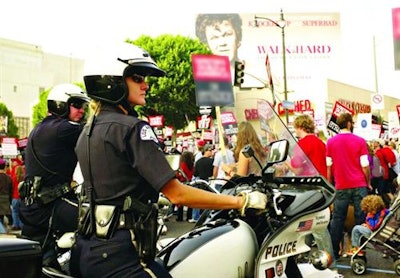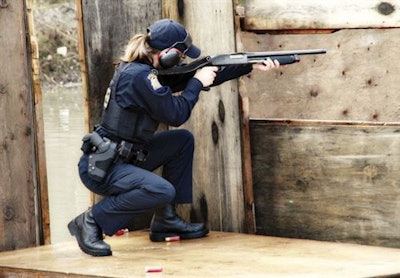You go, girl; you fight him, Officer Matt Patin thought as he grimly reviewed a security videotape of Nicola Cotton's fight for life. He watched as a paranoid schizophrenic twice Cotton's size repeatedly beat her with her own baton while onlookers ignored her predicament. For seven minutes, Patin's fellow New Orleans officer gave it her all until 44-year-old Bernal Johnson wrestled Cotton's sidearm from her and fired 15 rounds into her body. Patin wants to admire her warrior spirit and grieves that Cotton didn't prevail in her fight for life.
Cotton's death on January 28, 2008, portended a particularly violent year for female officers: Fifteen were killed in action that year. Some experts say the danger to female law enforcement officers can be reduced with training tailored to their needs.
If it has only recently become apparent that the dangers associated with working in law enforcement do not discriminate against women, it is because the demonstrable presence of women among our ranks has been relatively recent.
Between 1894—when Marie Owens became the first female police officer in the United States—and 1970, nine women were killed in the line of duty on U.S. soil. In this period women constituted a miniscule percentage of the profession's work force and they were usually tasked with non-hazardous duties.
The 1972 congressional passage of an amendment to Title VII of the Civil Rights Act of 1964 fostered optimism that women might one day achieve parity in the workplace. The subsequent influx of women into law enforcement has seen their representation swell from a mere two percent of U.S. law enforcement officers in 1970 to nearly 15 percent today.
Unfortunately, the growth in the ranks of female law enforcement officers has been accompanied by a corresponding increase in the number of female officers killed in the line of duty. To date, the names of more than 220 women officers have been engraved into the National Law Enforcement Officers Memorial in Washington, D.C.
While it would be precipitous to say that the job is becoming more dangerous for women officers, it is not unreasonable to ask if more can be done to ensure their safety.
Changing Demographics
One thing is sure; almost every American law enforcement agency is looking for good women who want to wear badges.
And of course, that hasn't always been supported by male officers who wonder if the emphasis on recruiting women means their agencies are relaxing requirements to achieve the desired demographics.
National Tactical Officers Association lead instructor Don Alwes wonders if these dissenting male officers have ever tried to imagine what law enforcement's women have to contend with on a daily basis.
"I'm a pretty good sized guy," notes Alwes. "Still, I wouldn't want to be going up against a guy who is 7 feet 5 inches, 350 pounds and all muscle. And that's fairly proportional to the types of situations some of our female officers find themselves dealing with routinely. It takes a certain inner strength to even be able to contemplate putting oneself in such situations, and my hat's off to them."
But rather than acknowledge that courage, some male cops fixate on the stature of the body containing it: "Too light to fight; too thin to win" is their condescending commentary on the quality of female officers.
Rather than try to compete with their male brethren in a head-to-head match of strength and machismo, female officers often exploit their own innate talents and skills: talking suspects down instead of charging into hand-to-hand fights and using officer safety tactics to improve their odds against larger opponents.
But such skills need to be fostered and practiced in order to be successful in the field. Toward that end, effective training is most crucial for women in law enforcement.[PAGEBREAK]
 Photo: Newscom.
Photo: Newscom.
Spatial Perception
Most law enforcement rookies enter some form of apprenticeship program that entails both academy and patrol training. Often, this apprenticeship is consciously conducted in as gender-neutral an environment as possible.
But should it be?
Vicky Farnham is vice president of Defense Training International and co-author of "Teaching Women to Shoot, A Law Enforcement Instructor's Guide" and "Women Learning to Shoot, A Female Officer's Guide." Farnham suspects that in their determination to treat women the same as men, law enforcement agencies may inadvertently give them the short shrift. And nowhere is this more pronounced than in firearms training.
Farnham cites presumptions associated with spatial relationships as a prime example of an ongoing inability of law enforcement trainers to recognize fundamental differences in the biological makeup of men and women.
"For many men, it's intuitive to look at the gun and figure out what this lever does, what that lever does, and move forward," Farnham observes. "Range instructors often accept this as a given for all students, but it's not. Men naturally tend to be more intuitive about how things work."
Citing natural encoding, Farnham notes that the caveman's "hands-on" approach to rock throwing gave him the "hunter/gatherer" edge. "Our ancestors' desire to chow down on a wooly mammoth depended upon his ability to wield a rock. The heft of the rock...the velocity with which it might be thrown...how hard it would impact. These were mechanical things that men routinely dealt with," Farnham explains.
Deprived of such evolutionary baggage, Farnham contends that women are less intuitive when it comes to mechanical
applications.
"The female brain can come to understand how hard to throw that rock," Farnham emphasizes. "But generally speaking, somebody has to explain it to her. If not in words, then through a diagram or demonstration. Because our capability in understanding spatial relationships is spread throughout our brain. With men, the right side of their brain is set up to understand spatial relationships intuitively."
One of the most conspicuous examples of where this need for spatial education of women officers becomes apparent is at the firing range. Many instructors just don't want to take the time to answer female recruits' questions nor do women recruits want to ask the questions, which they fear may embarrass them.[PAGEBREAK]
 Photo: Zuma Press.
Photo: Zuma Press.
"Female brains really thrive on detail and minutiae," says Farnham. "But it takes time for an instructor to explain details which he thinks everybody ought to already understand."
Sight Pictures
Debra S. Frigulti, a senior instructor with Oregon-based Police Training Consultants, agrees with Farnham. "Women tend to learn things in detail," says Frigulti, who routinely teaches patrol tactics to women officers.
"When I teach sights, I teach sight alignment and sight picture separately," Frigulti explains. "Being detail oriented, once women understand the correct alignment of the front sight through the rear sight window and particularly that their focus has to be on the front sight, then they can place it correctly on the target, which is their sight picture. I will even have them thread the eye of a needle to understand where their focus has to be. Because the human eye is set to infinity, a shooter, male or female, has to make a conscious effort to focus on the front sight. The problem is our eye is constantly seeking the point of danger rather than the front sight. Only continuous training will develop the muscle memory of the eye to seek the front sight.
"We spend a lot of time on wound ballistics so women understand how critical correct shot placement is," Frigulti adds. "Even with a shot directly to the heart or aorta, there is enough oxygen in a perpetrator's system to allow him to return fire for up to 15 seconds. Enough where an officer could still be wounded or killed. That's why sight picture, the placing of the correctly aligned sights on the target, is so critical."
Frigulti points to the success of Russia's female snipers in the Second World War as a prime example of what women are capable of when it comes to firearms.
"Women have no problem with pulling a trigger, but they need to learn skills in detail," concludes Frigulti. "But when you're given a limited amount of time [for training], sometimes you don't get into the details. In my three-day female school, we explain the fundamentals in detail."
If Farnham and Frigulti lament the lack of training time available to all officers, they also regret the dearth of qualified instructors.
"There are those instructors who somebody pointed the finger at and said, 'You're going to be the instructor for the next year,'" notes Farnham. "They have no instructor training. They might be a good shooter, but that doesn't mean they're a good instructor. Add a student who's a little intimidated by learning how to shoot a gun because that's not been a part of their life before and cap it off with a limited amount of time, and that's a recipe for a lack of success."[PAGEBREAK]
Making Adjustments
If time and the ability to successfully communicate are two concerns, insensitivity to the unique needs of a student is another. When the pride of an instructor's ability to execute techniques is paired with the belief that any deficiency in student performance is attributable to mental or physical shortcomings of the student, it is the student who ends up the loser.
Mike Siegfried, an instructor with the San Bernardino (Calif.) Sheriff's Office, notes that the lack of flexibility of some instructors may be harmful to either gender. "We in law enforcement have traditionally been taught a one-size-fits-all approach," reflects Siegfried. "Everybody is taught the exact same technique in the exact same way."
Siegfried explains that the more astute instructors tailor their programs to meet the needs of their officers. "The officer who is 6 foot 4 inches and 250 pounds might be able to do certain techniques with ease," he says. "But some of those weapons retention and defensive tactics techniques need to be modified for the female or any officer of smaller stature. In fact, some of these techniques should not be necessarily looked at as a "go-to" technique for a smaller stature officer. You need to make the techniques more leverage based because that will allow that smaller officer to be able to perform that technique in real time."
Siegfried says that simple adjustments can make certain techniques more effective for smaller statured officers, including some women.
"As an example, many academies will teach the standard arm bar where you grab the wrist, extend the arm out, and lock the elbow. Most trainers will have you use the dominant hand to grab the wrist and the off hand will take the palm and lock the elbow out. But the smaller stature officer will use the ulna bone to create much more leverage and quicker compliance with the suspect. This could make the difference between successfully doing that technique or having that person still resist and be much too close to the officer," Siegfried explains.
Debra Frigulti says such adjustments can also help women become better shooters.
"If you put a woman on a long gun, women do not always have the physical ability to handle an 870, but if they use their bone structure, then they do. I teach women that they do have the ability to do that. When they're in a male environment, oftentimes men will remind them that they don't belong there and they can't do it. I remind them just the opposite: They do belong there and they can do it. There are enough predecessors to show them that they can.
"When a woman slings up off of a supporting bag or tripod, the weapon can be incredibly heavy in a standing off hand, sitting, or kneeling position," Frigulti details. "But if a woman relaxes into her bone structure rather than try to use her muscle mass and muscle the gun, she loses the tremor in the muscles and her bone structure will more than adequately support that 700 sniper rifle, even with a bull barrel. Those are things that come with time and training, but oftentimes in a limited class there isn't time to learn that."
Mark Wammack is the patrol rifle coordinator with the Dallas Police Department. Wammack notes that more consideration can be given on the logistical front, as well.
"Many department quartermasters stock belts that are just too big for their smaller frame recruits," Wammack says. "True, you need room for all the things that go on the Sam Brownes: holster, mag pouches, etc. But while we've got the utility belt for Batman, we need one for Batwoman."
Wammack says Dallas' efforts to make firearms usage more user-friendly to women officers include going to E2 grips on its SIG 226 and 229 pistols, which provide better trigger finger fit for smaller framed personnel. The department also added the short trigger pull models and often combines the two for personnel with very small hands. Dallas PD also uses short stocks on its 870 shotguns and six-position collapsible stocks on its patrol rifles.
Leveling the Field
Irrespective of gender, most contemporary officers recognize that whatever genetic, hormonal, social, or psychological differences exist between the sexes, the will to survive may be the trump card. And with the right training, female officers can match or exceed the performance of their male counterparts.
Those male officers who still refuse to see the light might want to ask themselves if they have the strength and determination of Orange County (Fla.) Sheriff's Dep. Jennifer Fulford who persevered against two armed men in a garage shootout, killing her assailants despite having been shot nine times. Or Fort Hood, Texas, Police Sergeant Kim Munley who, despite being wounded herself, was able to stop accused Fort Hood shooter Nidal Hasan, who'd already killed 13 and wounded numerous others.
Both of these officers credited their training for helping them prevail against determined gunmen. The goal of all law enforcement trainers should be to use every tool and technique in their possession to ensure that all of their students, both male and female, perform as well under fire.
Related:


















